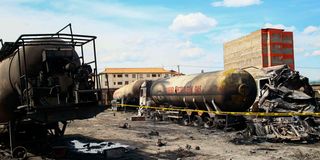Experts: How Embakasi blast ‘doubled pollution levels in Nairobi’

View of what remained after a huge gas blast in Embakasi Nairobi caused loss of lives, property and injuries on February 2, 2024.
Scientists at the University of Nairobi (UoN) have recorded a spike in carbon monoxide and fine particulate matter((PM2.5) which they say was brought about by the Embakasi gas tragedy.
Prof Nicholas Oguge, an expert in environmental policy at UON’s Faculty of Law, says pollutant levels in Kenya’s capital rose to 4.4 parts per million (ppm) from 2.0 ppm days after the blast, thus obliterating the World Health Organization (WHO)'s recommended daily limit of 4.0 ppm.
“We used an air quality sensor that we have set up at our parklands campus and at that time, for a period of time in that area after the explosion there was rampant carbon monoxide poisoning.
In Nairobi, we usually measure 2.0 ppm and the WHO recommends that up to 4.0 ppm is quite safe but following the explosion, we measured 4.4 ppm which is slightly higher than what WHO recommends, “he pointed out in an exclusive interview at the weekend.
According to Prof Oguge, fine inhalable particles, when taken in through the nose, not only get into your lungs but also bloodstream.
“Carbon monoxide is very poisonous and if you inhale 9 ppm, you are likely to have very serious health impacts and even death,” he explained, noting that particles are defined by their diameter for air quality regulatory purposes.
Remember we are measuring this from Parklands campus which is 10 kilometers away from where the explosion occurred,” the professor said.
“There are various censors that we use and that will be dependent on the source and wind direction.
On that particular night when the explosion happened, the wind was blowing from north east to south west and the speed was about three kilometers per hour. That meant after some time, we were able to capture some of the pollutants that got there and given the wind was blowing south west, it is possible that we did not capture some other pollutants that passed through,” the environmental policy expert told the Nation.
“If you look at the fine inhalable particles we measured 28 µg/m3(microgram per cubic meter), the WHO recommended daily value is 15 µg/m3 around midnight.
For this, our censor is at Embakasi Primary school but that is a bit north of where the explosion occurred so it’s possible it could have missed some of the pollutants,” said the scientist.
However, he noted that by morning, it was down to around 15 µg/m3.
He advises those people going to the scene of the gas tragedy to take caution.
“Whether you are a journalist covering the situation or the people who are there for clean-up they are still susceptible to some health risks even after the fire.
There’s risk from ash, dust, soot, carbon monoxide and sulphur dioxide as well,” he said, adding that since plastics got burnt, such areas have a number of chemicals known as volatile or organic chemicals which have polycyclic organic matter (POM), consisting of a mixture of hundreds of chemicals as well as Polycyclic Aromatic Hydrocarbons (PAHs), a class of organic compounds produced by incomplete combustion or high-pressure processes.
“All these chemicals harm humans and potentially lead to cancer but the particulate matter that we were measuring can lead to respiratory conditions and cardiovascular diseases while the carbon monoxide can lead to death.”
While responding to a series of queries from the Nation, Prof Oguge said that those who were closer to the scene of the tragedy are at risk of developing cancer due to the proximity to the loads of pollutants emitted such as heavy metals, dioxins and organic chemicals.
On what one should do when such a tragedy happens to protect themselves, Prof Oguge urges precaution.
“If you can avoid going there until it is cleaned up, the better, but if you have to go there, wear face masks to reduce inhalation of pollutants.
"For those who live there, it is advisable to wear masks all the time until the place is properly cleaned," he advised.
He urges the government to ensure there aren’t any such LPG and industrial facilities in the heart of residential areas.
“They are high risk engagements, the government as well as companies dealing with such need to undertake risk mitigation measures but that will be very possible if there are existing laws.”





